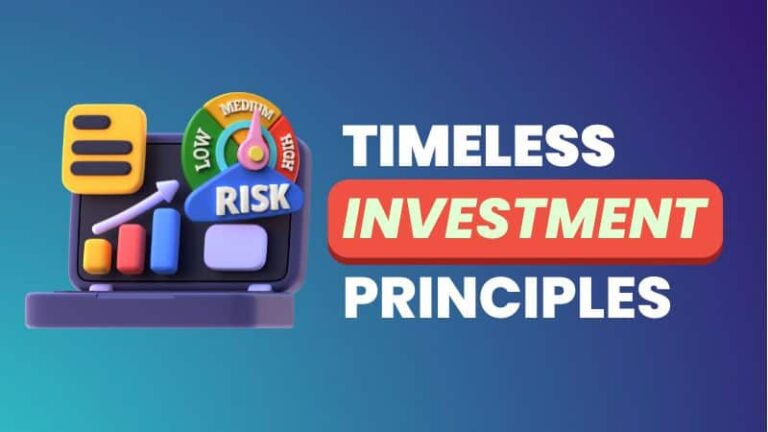How to Start Investing for Beginners: The Ultimate Guide
What if you could grow your money without having to work for extra hours? By following this investing guide for…

What if you could grow your money without having to work for extra hours? By following this investing guide for beginners, you can achieve financial freedom and watch your investments flourish.
As Robert Kiyosaki’s rich dad mentioned in his book Rich Dad, Poor Dad, “The rich don’t work for money. They let money work for them.” This idea struck me hard when I first read the book in my junior year in college. The book completely changed the way how I think about money.
Many people have turned their savings into thriving portfolios by sticking to these proven steps. This isn’t just for the wealthy or the financial experts—this guide is designed for every Juan, especially for hardworking Filipino millennials and young professionals like you.
Ready to see how your hard-earned money can work harder for you? Dive in and discover the secrets to smart investing.
Understanding Investing Basics

Understanding these basics is crucial before diving into the investment world. Trust me, when I first started JuanInvestor, I wished someone had broken it down for me in simple terms. I also recommend reading our other posts on investment terms, goals, and principles.
What is Investing?
What is investing? Investing is essentially the act of putting your money into financial schemes, shares, property, or a commercial venture with the expectation of achieving a profit.
Think of it as planting a seed today to enjoy the fruits tomorrow. Unlike saving, where you tuck money away in a bank, investing aims to make your money grow over time.
Read more about savings vs investment.
When I first stepped into the investing world as a young industrial engineering grad, I realized how powerful it can be for financial growth.
Now, as a digital marketing agency owner and the founder of JuanInvestor, I’ve seen how strategic investments can transform lives, especially for Filipino millennials and young professionals like you.
Why Invest?
So, why should you even bother investing? Investing is important, as I mentioned in my other post. And there are several compelling reasons:
- Financial Growth: Investing allows your money to grow, often beating the returns you’d get from a traditional savings account. Over time, the power of compound interest can significantly boost your wealth. (Tip: Refer to our compound interest calculator to see it in action.)
- Passive Income: Passive income helps you earn money while you sleep. That’s the beauty of investing. Whether it’s dividends from stocks or rental income from real estate, the best investments can generate additional income streams.
- Inflation Protection: Inflation erodes the purchasing power of your money. Investing in assets that appreciate over time helps protect your money from losing value. (Tip: Read our other post about inflation and how it affects your investments.)
When I started JuanInvestor, my goal was to share these benefits with fellow Filipinos, showing how anyone—regardless of their background—can build wealth through smart investing.
Types of Investments
Now, let’s dive into the different types of investments you can consider:

Stocks
Owning a piece of a company and benefiting from its growth (see the top online stock brokers in PH for your reference)

Bonds
Lending money to a company or government in exchange for periodic interest payments

Mutual Funds
Pooling your money with other investors to buy a diversified portfolio of stocks or bonds (see the top mutual fund companies in the Philippines)

Real Estate
Buying a property (foreclosed properties is one option) to generate rental income or appreciate in value

Cryptocurrency
Digital currencies like Bitcoin and Ethereum, which have gained popularity recently
In my early days of corporate, I invested in mutual funds and Philippine stocks primarily in Jollibee, Ayala, SM, and San Miguel shares. In recent years, I started investing in high-risk, high-reward investments like crypto. These experiences have enriched my knowledge and equipped me to guide you on your investing journey.
How to Set Yourself Up for Investment Success

Setting up for investment success isn’t just about picking the right stocks or funds; it’s about laying a solid financial foundation. These steps will not only make you a more informed investor but also help you navigate on the right foot, in the muddy waters of the financial world with confidence.
The exact steps needed to start investing for beginners.
Step 1: Assess Your Financial Situation
Before we dive headfirst into the world of investing, let’s take a step back and assess where you stand financially. It might sound tedious, but trust me, this is crucial.
1. Start by calculating your net worth, which is simply your assets minus your liabilities. This will give you a clear picture of your financial health.
2. Understanding your risk tolerance is another key aspect. Are you someone who can handle the ups and downs of the stock market, or do you prefer safer, more stable investments?
Knowing this will help you make informed decisions that align with your comfort level. When I launched my digital marketing agency, I applied the same principles. I assessed the risks, understood my financial standing, and made strategic decisions. This experience has been invaluable in my investing journey and I’m excited to share these insights with you.
Step 2. Set Financial Goals
Now that you have a grasp on your finances, it’s time to set some goals. But not just any goals—SMART goals. This means they should be Specific, Measurable, Achievable, Relevant, and Time-bound.
The formula is simple: I want to achieve [PHP amount] in [Y time] for my [financial/personal goal].
Example: I want to have PHP 100,000 in 3 years for my travel fund in Europe.
For instance, you might want to save for a down payment on a house in five years or build a retirement fund by the time you’re 60. Having clear, actionable goals will keep you motivated and focused.
Step 3. Create a Budget
Before you start investing, it’s essential to have a budget. This ensures you’re not investing money you can’t afford to lose. List all your income sources and expenses to see how much you can comfortably invest each month.
Creating a budget might seem daunting, but it’s a game-changer. When I founded JuanInvestor, I realized that many young professionals struggle with budgeting. That’s why I emphasize its importance—it’s the foundation of any successful investment plan.
Building Your Investment Portfolio

Building a solid investment portfolio is like crafting a well-thought-out game plan. Here are the steps:
- Step 1: Diversify your investments
- Step 2: Allocate your assets
- Step 3: Choose an investment account
Step 1: Diversify your Investments
Simply put, diversification means spreading your investments across various assets to reduce risk. Think of it as not putting all your eggs in one basket.
When I started my digital marketing agency, I quickly learned the importance of not relying on a single client or strategy. The same principle applies to investing. Diversifying not only protects you but also opens up multiple avenues for growth.
For example, if you invest all your money in one stock and that company faces a downturn, your entire investment could take a hit. But if you diversify by investing in multiple stocks across different industries, bonds, and maybe some real estate, you’re spreading the risk. This way, if one investment doesn’t perform well, others might still thrive.
That is why I highly encourage everyone to invest in Index Funds. It’s a low-cost investment (cheaper than mutual funds), well-diversified and it doesn’t require active management of your portfolio.
Step 2: Allocate your assets
Now, let’s talk about asset allocation. This is about deciding how to distribute your investments among different asset classes like stocks, bonds, and real estate. Your asset allocation should align with your financial goals, risk tolerance, and time horizon.
For instance, if you’re young and have a high-risk tolerance, you might allocate a larger portion of your portfolio to stocks, which have higher growth potential but also higher risk. On the other hand, if you’re closer to retirement, you might prefer a more conservative mix with a higher percentage of bonds.
Step 3: Choose an investment account
Choosing the right investment accounts is just as important as picking the right assets. There are various types of accounts to consider, such as brokerage accounts, retirement accounts, and more. Each comes with its own set of benefits and tax implications.
For example, a regular brokerage account offers flexibility but is subject to capital gains tax. On the other hand, retirement accounts like the Personal Equity and Retirement Account (PERA) or Pag-IBIG Fund offer tax advantages but come with restrictions on withdrawals.
Certainly! Here’s an expanded section on “How to Start Investing” with the specified style and EEAT elements:
How to Start Investing

Starting your investment journey might seem overwhelming, but breaking it down into manageable steps makes it much easier. Whether it’s stocks, bonds, mutual funds, real estate, or cryptocurrency, the key is to do your research, diversify, and start small.
Investing in Stocks
Buying stocks means owning a piece of a company. When the company does well, the value of your shares increases, and you can earn dividends. But how do you pick the right stocks?
Do your research. Start by researching companies you believe in. Look at their financial health, industry position, and future growth potential. Diversify your stock picks across different sectors to spread risk.
When I first ventured into stock investing, I applied the analytical skills I honed during my college studies. It’s all about understanding the market and making informed decisions.
Investing in Bonds
Next up, Bonds. Think of bonds as loans you give to companies or governments. In return, they pay you interest. Bonds are generally less risky than stocks and provide a steady income stream.
There are different types of bonds, such as government bonds, which are safer, and corporate bonds, which offer higher returns but come with more risk. Diversifying your bonds can balance your portfolio.
Investing in Mutual Funds and ETFs
Mutual funds and ETFs (Exchange-Traded Funds) are fantastic options for beginners. These funds pool money from many investors to buy a diversified portfolio of stocks, bonds, or other assets. This way, you get instant diversification even with a small investment.
When choosing a type of mutual fund or ETF, look at factors like the fund’s performance history, fees, and the expertise of the fund manager.
Real Estate Investment
Real estate is another excellent investment avenue. You can invest directly by buying property or indirectly through Real Estate Investment Trusts (REITs). Owning property can provide rental income and potential appreciation in value.
REITs, on the other hand, allow you to invest in real estate without the hassle of property management. They pay dividends and are traded on stock exchanges, making them a liquid investment.
Cryptocurrency Investment
Lastly, let’s talk about the new kid on the block—cryptocurrency. Cryptos like Bitcoin and Ethereum have gained popularity for their potential high returns. However, they come with high risk due to their volatility.
If you’re considering investing in crypto, start small and invest only what you can afford to lose. Research thoroughly and stay updated with market trends.
Investment Strategies

Investment strategies are not one-size-fits-all. The world of investing is vast, and there’s no single “right” way to do it. The key is to find a strategy that aligns with your financial goals and risk tolerance.
1. Peso-Cost Averaging
Let’s start with a strategy that’s simple yet effective: peso-cost averaging. This involves investing a fixed amount of money at regular intervals, regardless of market conditions. The idea is that you buy more shares when prices are low and fewer when prices are high, averaging out the cost of your investments over time.
For example, if you decide to invest ₱5,000 every month in a mutual fund, you’ll keep doing that whether the market is up or down. This method takes the guesswork out of timing the market and helps you stay consistent.
The key here is consistency. Regardless of the market conditions you need to invest the same amount. In time, it will even out the prices, and your average acquisition price will be low.
2. Value Investing
Next, let’s talk about value investing. This strategy involves picking stocks that appear to be undervalued by the market. The goal is to buy these stocks at a lower price and hold them until their true value is realized.
This strategy is used and popularized by one of the most successful investors of all time: Warren Buffett.
Value Investing = Buy Low, Sell High
Value investors look for companies with strong fundamentals, such as solid earnings, low debt, and good management. It’s like finding a hidden gem in a sea of ordinary stones.
3. Growth Investing
If value investing is about finding hidden gems, growth investing is about riding the wave of high-potential companies. Growth investors focus on companies that are expected to grow at an above-average rate compared to others.
These companies often reinvest their earnings to fuel further growth, so they might not pay dividends. However, the potential for capital appreciation can be significant.
4. Dividend Investing
Dividend investing is a strategy that focuses on buying stocks that pay regular dividends. These payments provide a steady income stream, which can be particularly appealing if you’re looking for passive income.
Dividend stocks are often from well-established companies with a history of paying out profits to shareholders. While they might not offer the same growth potential as some other investments, regular income can be a great way to supplement your earnings.
In the Philippine stock market, PLDT, Ayala, and SM are my go-to companies that pay consistent dividends to their shareholders.
5. Impact Investing
Last but not least, let’s explore impact investing. This strategy involves investing in companies, organizations, and funds with the intention of generating social or environmental impact alongside a financial return. It’s about aligning your investments with your values.
For example, you might invest in companies that focus on renewable energy, sustainable agriculture, or social justice initiatives. Impact investing allows you to support causes you care about while still growing your wealth.
How to Manage and Monitor Your Investments

Remember, investing is a journey, not a destination. Managing and monitoring your investments is an ongoing process that requires regular attention and adjustments. By following these tips, you can ensure your investments are always aligned with your financial goals.
1. Regular Portfolio Reviews
Managing your investments doesn’t stop after you’ve made your initial choices. Regular portfolio reviews are essential to ensure your investments still align with your goals. Think of it as a health check-up for your finances.
At least once or twice a year, take a close look at your portfolio.
- Are your investments performing as expected?
- Have your financial goals or risk tolerance changed?
This is the time to make any necessary adjustments.
2. Rebalancing Your Portfolio
Rebalancing is the process of realigning the weightings of your portfolio assets. Over time, some investments will perform better than others, causing your portfolio to drift from its original allocation. Rebalancing ensures you maintain your desired level of risk.
For example, if your target allocation is 60% stocks and 40% bonds, but your stocks have grown to 70%, you’d sell some stocks and buy more bonds to get back to your original mix.
3. Staying Informed
The investment landscape is constantly changing, so staying informed is crucial. Read financial news, follow market trends, and keep up with new investment opportunities. Knowledge is power, and being well-informed helps you make better investment decisions.
4. Continuing Education
Investing is a lifelong learning process. Consider taking courses, attending seminars, or reading books on investing. The more you learn, the better equipped you’ll be to make smart investment decisions.
Common Investment Mistakes to Avoid

Investing is a journey filled with learning opportunities. Avoiding common investment mistakes can significantly improve your chances of success. Here are some useful tips.
1. Emotional Investing
One of the biggest pitfalls for investors is letting emotions drive decisions. It’s easy to get swept up in the excitement of a booming market or panic during a downturn. But emotional investing can lead to buying high and selling low—essentially the opposite of what you want to do.
2. Lack of Research
When I was in college, thorough research and analysis were integral to creating comprehensive business plans.
Investing without doing proper research is like jumping into a pool without knowing how deep it is. Understanding the fundamentals of what you’re investing in is crucial. This includes researching the company, its financial health, market position, and growth potential.
3. Timing the Market
Trying to time the market—buying low and selling high—is tempting but notoriously difficult. Even seasoned investors struggle with it. Instead of trying to predict market movements, focus on long-term strategies and consistency.
4. Ignoring Diversification
Putting all your money into a single investment is risky. Diversification—spreading your investments across different assets—helps manage risk and can lead to more stable returns.
5. Overlooking Fees
This one is easy to miss! Investment fees can eat into your returns if you’re not careful. Whether it’s management fees for mutual funds, trading fees for stocks, or hidden charges, these costs add up over time. Always be aware of the fees associated with your investments and look for low-cost options when possible.
6. Following the Herd
“Dogecoin, to the moon!“
Just because everyone else is investing in a particular stock, crypto or asset doesn’t mean you should too. Following the herd can lead to buying into bubbles or making investments that don’t align with your financial goals. Stick to your strategy and make decisions based on thorough research and analysis.
Resources and Tools for Investors

Investing is a continuous learning process. Using the right resources and tools can significantly enhance your investing experience. These tools can provide the support and information you need to make informed decisions.
Investment Apps
In today’s digital age, investment apps have made it incredibly easy to start investing right from your smartphone. These apps offer a range of features, from real-time market data to automated investing. Some popular investment apps in the Philippines include COL Financial, BPI Trade, and First Metro Sec.
These platforms are user-friendly and provide a wealth of information to help you make informed decisions. They also often come with lower fees compared to traditional brokerage services.
Educational Resources
Knowledge is power, especially when it comes to investing. There are numerous educational resources available that can help you understand the intricacies of investing. Websites like Juan Investor, and Investopedia, books like “Rich Dad Poor Dad” by Robert Kiyosaki, and online courses on platforms like Coursera and Udemy are excellent places to start.
Financial Advisors
Sometimes, having a professional guide you through your investment journey can make a world of difference. Financial advisors can provide personalized advice based on your financial situation and goals. They can help you create a comprehensive investment plan, manage your portfolio, and offer insights that you might not have considered.
Online Communities
Joining online investment communities can provide support, share insights, and keep you motivated. Platforms like Reddit’s r/phinvest, r/investing, r/Money, or local Facebook groups focused on investing can be great places to learn from others’ experiences, ask questions, and get advice.
Investment Newsletters
Subscribing to investment newsletters can keep you updated on market trends, new opportunities, and expert opinions. Some popular newsletters include Morningstar, Bloomberg, and The Motley Fool. These newsletters provide valuable insights and can help you stay informed without having to sift through tons of information.
FAQ
What is the best age to start investing?
The best age to start investing is as early as possible. The earlier you start, the more time your investments have to grow through compounding. Even if you’re in your 20s or 30s, it’s never too late to begin.
How much money do I need to start investing?
You can start investing with little money for as low as ₱1,000. Many investment apps and platforms allow you to begin with small amounts, making it accessible even if you’re on a tight budget.
What is an emergency fund, and why is it important before investing?
An emergency fund is a savings fund meant for unexpected expenses, like medical emergencies or job loss. It’s crucial to have this in place before investing to ensure you’re not forced to sell investments prematurely.
What are index funds, and should I invest in them?
Index funds are mutual funds or ETFs that aim to replicate the performance of a specific index, such as the PSEi. They are a good option for beginners due to their low fees and diversification benefits.
How do I track my investment performance?
You can track your investment performance using financial apps, brokerage platforms, or spreadsheets. Regularly monitoring your investments helps you stay informed about how your portfolio is doing.
What’s the difference between active and passive investing?
Active investing involves frequently buying and selling stocks to beat the market, while passive investing involves a more hands-off approach, like investing in index funds, to match market performance. Both have their pros and cons.
Can I invest if I have debt?
It’s generally advisable to pay off high-interest debt before investing. However, if your debt has a low interest rate, you can start investing while gradually paying off your debt. Balance is key.
Conclusion
Investing might seem daunting, but with the right knowledge and tools, you’ve got this! From understanding basics to building and managing your portfolio, and avoiding common mistakes, you’re now equipped to start your investment journey.
Remember, it’s not about getting rich quick; it’s about making smart, informed decisions for long-term growth. Let’s take control of our financial future together—one smart investment at a time. Happy investing!






